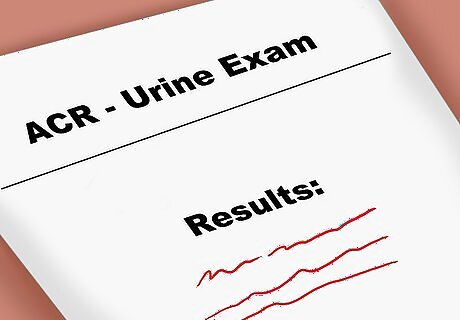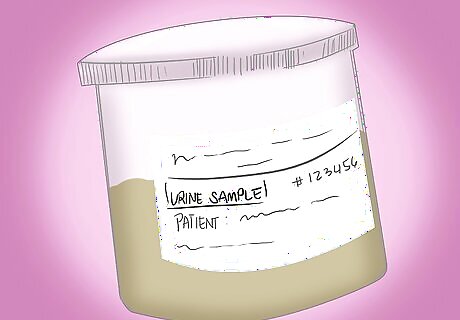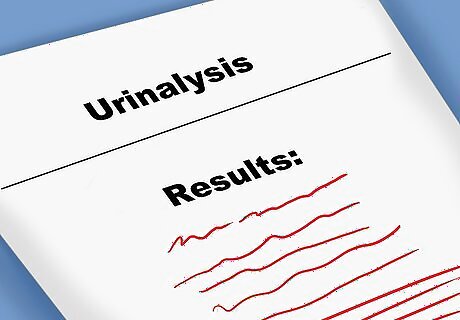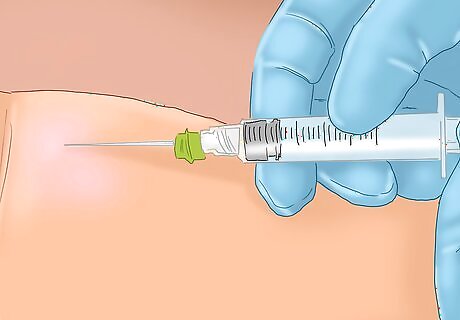
views
Receiving a Urine Test

See your physician for a urine "ACR" to test your kidney function. The urine "ACR" stands for the "albumin to creatinine ratio." Albumin is a protein that is normally present in your blood, and that should generally NOT be filtered in excess quantities through your kidneys into your urine. It is for this reason that protein in your urine (such as albumin) can be indicative of kidney disease. If your urine ACR comes back "positive," the test should be repeated for confirmation. You need at least 3 measurements of elevated protein (albumin) in your urine over 3 or more months in order for it to be diagnostic of chronic (ongoing) kidney disease.

Understand that you may receive a "random" urine test or a 24-hour test. If you and your doctor opt for a "random" sample, you will be asked to submit a one-time urine sample to the lab which can give a snapshot view as to the amount of protein present in your urine at that time. Technically, the 24-hour urine test is more accurate than just providing one sample, as it allows your doctor to calculate the average amount of protein in your urine over a full day. However, it is also more cumbersome as you will need to collect ALL of your urine over the course of 24 hours, every time you go. It is important to discuss the pros and cons of each option with your doctor. A random urine sample may be sufficient to diagnose protein in your urine. If your results are borderline, however, you may be asked to complete the 24-hour urine test for a more detailed assessment of the amount of protein in your urine over the course of a full day.

Ask your doctor for a "urinalysis" to gain additional information about your kidney function. In addition to the more basic test of looking for protein in your urine, a "urinalysis" also examines your urine under the microscope checking for any red blood cells, white blood cells, or other unusual things that may be present in your urine. If your urine is positive for red blood cells or white blood cells when the doctor looks under the microscope, this is oftentimes a sign of kidney damage. Blood cells are normally too large to be filtered through the kidneys. Therefore, their presence in the urine can indicate problems with the kidneys' filtering system that would allow such large cells to get through. The blood cells can also indicate problems with the bladder or ureters.
Receiving a Blood Test

See your physician for a blood test to evaluate your kidney function. There are a few different things that can be measured in a blood test that can provide valuable information to your doctor about your kidney function. These can all be measured via the same blood test. They include: the creatinine, the eGFR (estimated glomerular filtration rate), the BUN (blood urea nitrogen), and the creatinine clearance. The results you receive on these blood tests will be very effective at testing your kidney function. They will indicate to your physician whether there are any signs of kidney disease - either acute (short-term) problems, or signs of chronic and ongoing kidney troubles.

Interpret the significance of your creatinine and eGFR results. Creatinine is a waste product that accumulates in the blood. With normal healthy kidneys, the creatinine waste product is effectively removed from the blood via the kidneys which filter it out through the urine. When you have kidney disease, however, the rate at which creatinine is filtered and removed from your blood slows, leading to a build-up of this waste product that can subsequently be detected on blood tests. The purpose of measuring creatinine is that it provides insight into your kidney function, and also allows your doctor to calculate the eGRF (the estimated glomerular filtration rate). The eGFR is not a quantity that is directly "measured" via the blood test; rather, it is calculated (approximately) based on your creatinine reading. The calculated value for eGRF that your doctor comes up with based on your creatinine results is another important way to evaluate kidney function, because it gives insight as to the rate at which the glomeruli in your kidneys are filtering blood. A creatinine level between 0.5-1.5mg/dL is considered normal in men, and 0.6-1.2mg/dL is considered normal in women. An eGFR above 60mLs/min/1.73 square meters is considered indicative of normal and healthy kidney function (as long as you do not have other signs or symptoms of kidney disease). An eGFR below that is diagnostic of kidney disease.

Receive BUN (blood urea nitrogen) and creatinine clearance tests. BUN is another waste product that can build up in the blood when the kidneys are not functioning adequately, and is hence used as a potential sign of kidney disease or acute kidney impairment. The downside to BUN is that this waste product may also be elevated in other disease states, such as for patients with congestive heart failure, or in the midst of a heart attack or in shock. The benefit to BUN, however, as opposed to simply using the creatinine waste product measurement, is that an elevated BUN is less likely to have false positive results than an elevated creatinine. The creatinine clearance rate is when the creatinine measurement in your blood is compared to the creatinine measurement in your 24-hour urine test. Your physician can then determine the rate at which creatinine is being filtered from your blood through your kidneys into your urine.
Testing For Concurrent Diseases That May Exacerbate Kidney Disease

Have your blood pressure measured. In addition to receiving both urine tests and blood tests, if your doctor suspects that you may have a kidney problem (either acute or chronic) it is key that you receive regular blood pressure measurements as well. This is because high blood pressure may contribute to kidney disease. If your blood pressure is high, talk to your doctor about dealing with that as soon as possible. A high blood pressure is defined as a reading over 140 systolic (the top number) or over 90 diastolic (the bottom number). Generally, your doctor will perform a few blood pressure measurements over time in order to get your average (and to ensure that he or she does not diagnose you with high blood pressure based on just one blood pressure reading, but rather, based on several). There are several treatments available for high blood pressure (medically called "hypertension") if you are found to have it. Getting your blood pressure under control will likely have a beneficial effect on improving your kidney function, as well.

Get tested for diabetes. It is important to understand that diabetes is a major risk factor for kidney disease. If you have diabetes, you need to be screened for kidney disease at least once a year, even if you have no signs or symptoms that are suspicious of kidney disease. This is because there is a very strong correlation between diabetes (particularly diabetes with continually uncontrolled blood sugar levels) and the development of kidney disease as a complication of elevated blood sugar levels. To get tested for diabetes, you can have your glucose levels as well as your HbA1c (Hemoglobin A1c, a long-term measure of your sugar levels) measured via a blood test. Following through with all recommended treatments for diabetes, if you are indeed diagnosed with it, is key to delaying the development of kidney disease and/or to preventing it from becoming worse, if you already have it. Besides this, maintaining a healthy weight and avoiding smoking are effective ways to maintain healthy kidneys.

Receive further kidney evaluations as necessary. If your urine and blood tests show evidence of kidney disease, you may need to proceed with further investigation such as imaging and/or a kidney biopsy. Directly looking at your kidneys, either with an imaging test or with a biopsy, can help your doctor to diagnose the underlying cause of your kidney problems, if this remains unknown. Imaging tests and/or biopsies are generally reserved for more severe cases where the underlying cause of your kidney disease remains unknown. These additional investigations may be key in helping your doctor create an appropriate treatment plan.




















Comments
0 comment